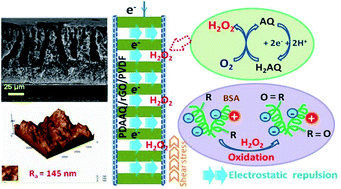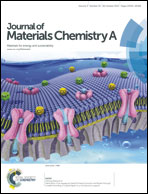Hydraulic power and electric field combined antifouling effect of a novel conductive poly(aminoanthraquinone)/reduced graphene oxide nanohybrid blended PVDF ultrafiltration membrane
Abstract
Membrane fouling is still a bottleneck problem towards the wide-spread applications of membrane bioreactors (MBRs) for wastewater treatment/reclamation. Thus, membrane modification has ever been a hot topic for improving the separation efficiency and antifouling ability of membranes. In this study, a novel conductive and hydrophilic poly(1,5-diaminoanthraquinone)/reduced graphene oxide (PDAAQ/rGO) nanohybrid blended polyvinylidene fluoride (PVDF) membrane was prepared by the phase inversion method. The fabricated PDAAQ/rGO/PVDF membrane was characterized by different characterization techniques. The effect of additive content on the membrane structure and antifouling performance was evaluated. An obvious growth in pore size/porosity and surface roughness was observed for the 1.5 wt% PDAAQ/rGO nanohybrid blended membrane, which caused higher hydrophilicity, pure water flux and fouling resistance than those of the pristine PVDF membrane. By applying an appropriate external electric field of 1.0 V cm−1, the conductive PDAAQ/rGO nanohybrid blended PVDF membrane exhibited an admirable electrocatalytic activity towards the oxygen reduction reaction, and 8.84 mg L−1 H2O2 was accumulated within 30 min electrolysis. Meanwhile, the conductive PDAAQ/rGO/PVDF membrane displayed superior fouling removal ability along with a higher water flux recovery ratio after electric cleaning. Applying bovine serum albumin as the model protein and 1.0 V cm−1 external electric field, the fouling rate of the conductive PDAAQ/rGO/PVDF membrane decreased by about 63.5% when compared with the control test during the long-term continuous-flow membrane filtration process. The cross-flow shear stress induced by aeration scouring, the increased electrostatic repulsion force induced by the external electric field and the in situ electro-generated H2O2 contributed to the prominent fouling mitigation and fouling resistance.


 Please wait while we load your content...
Please wait while we load your content...